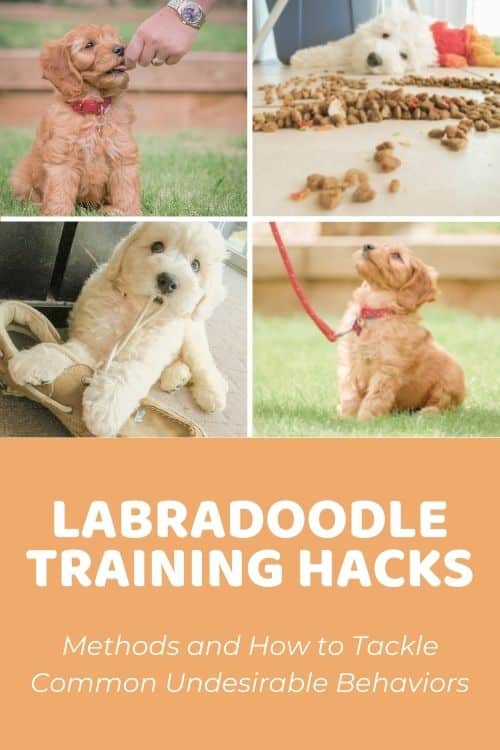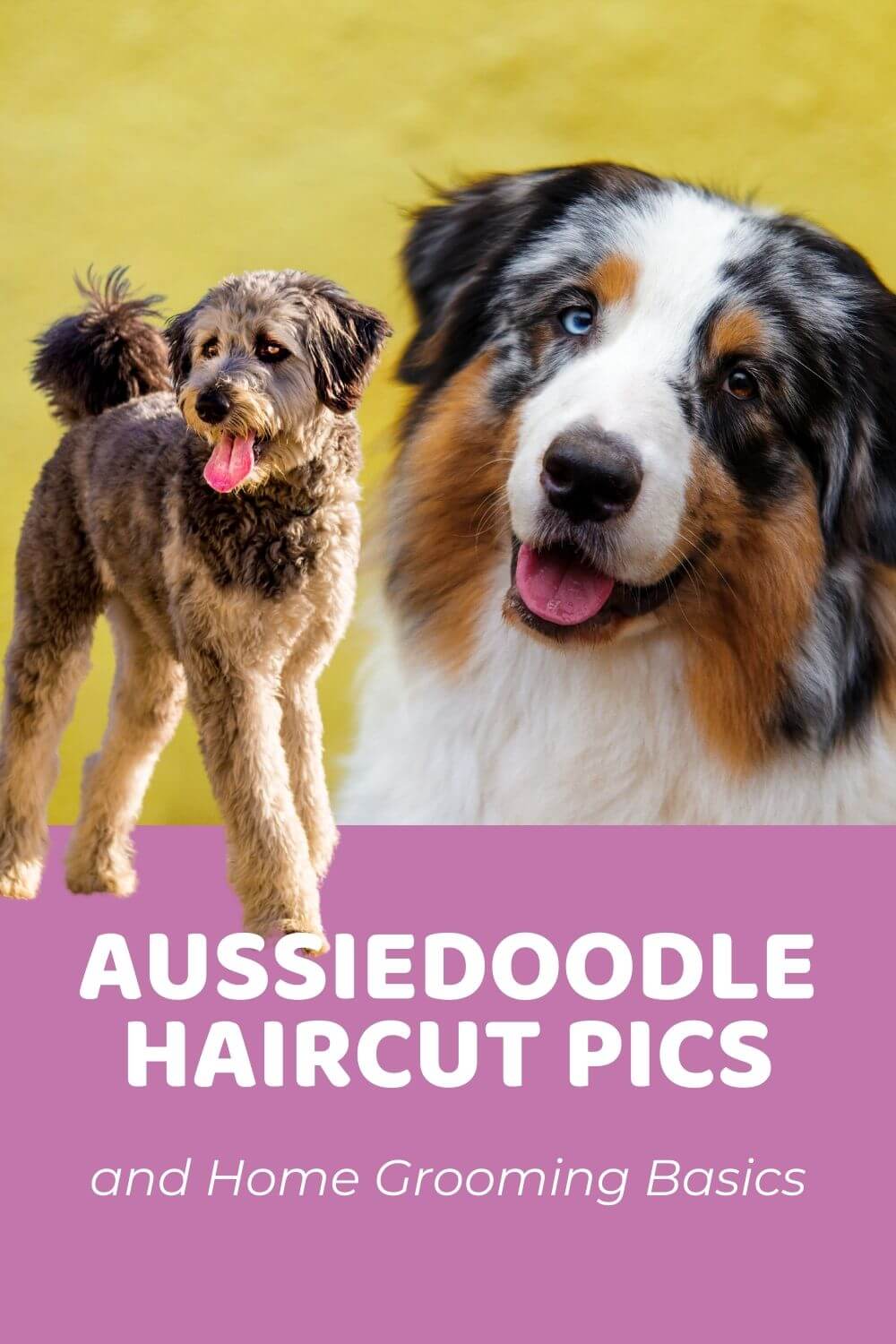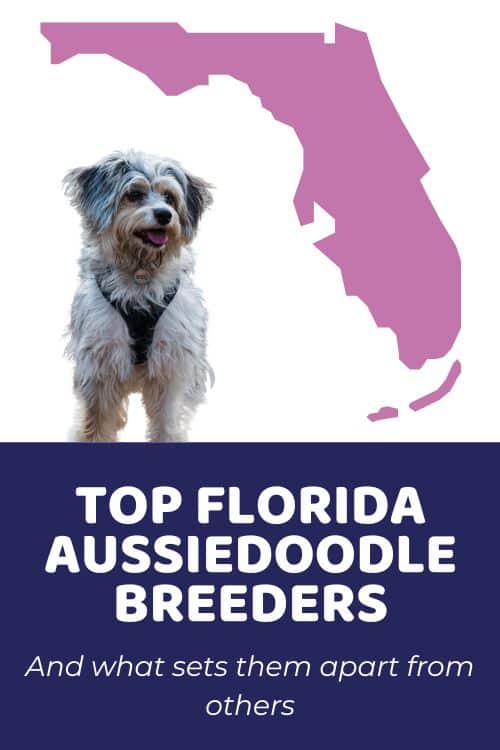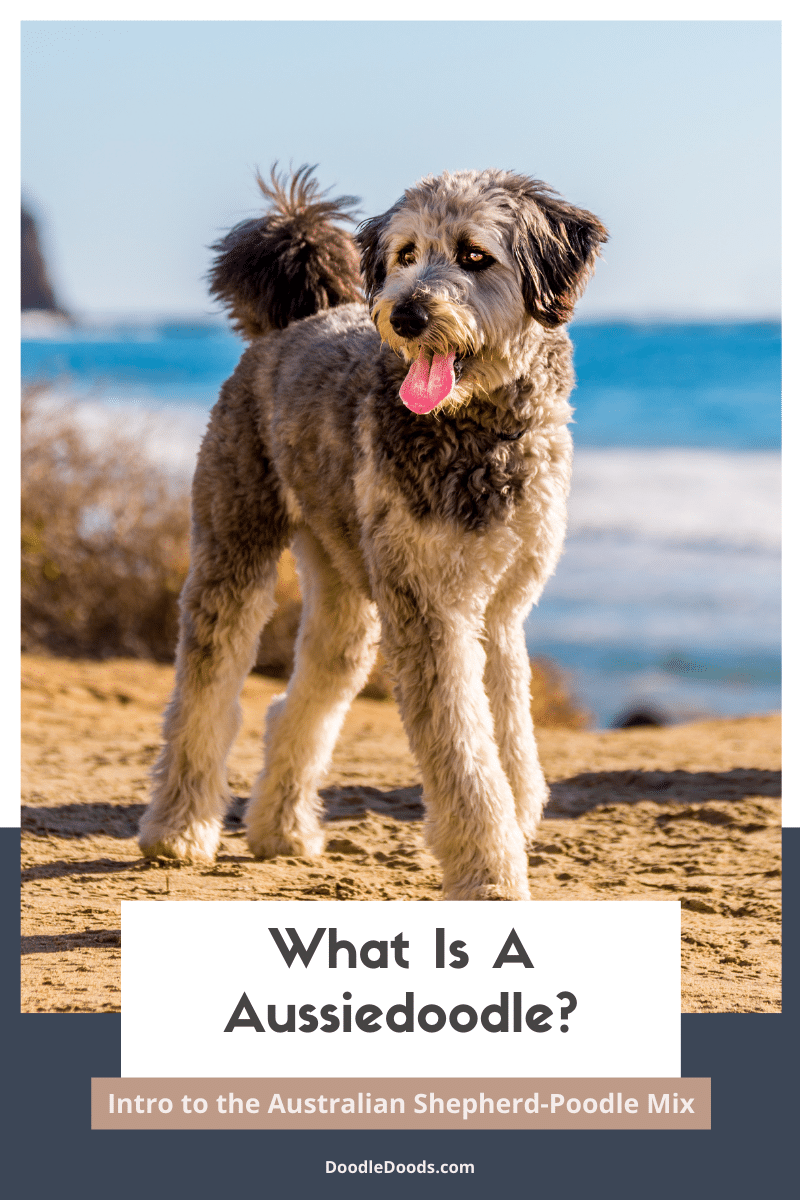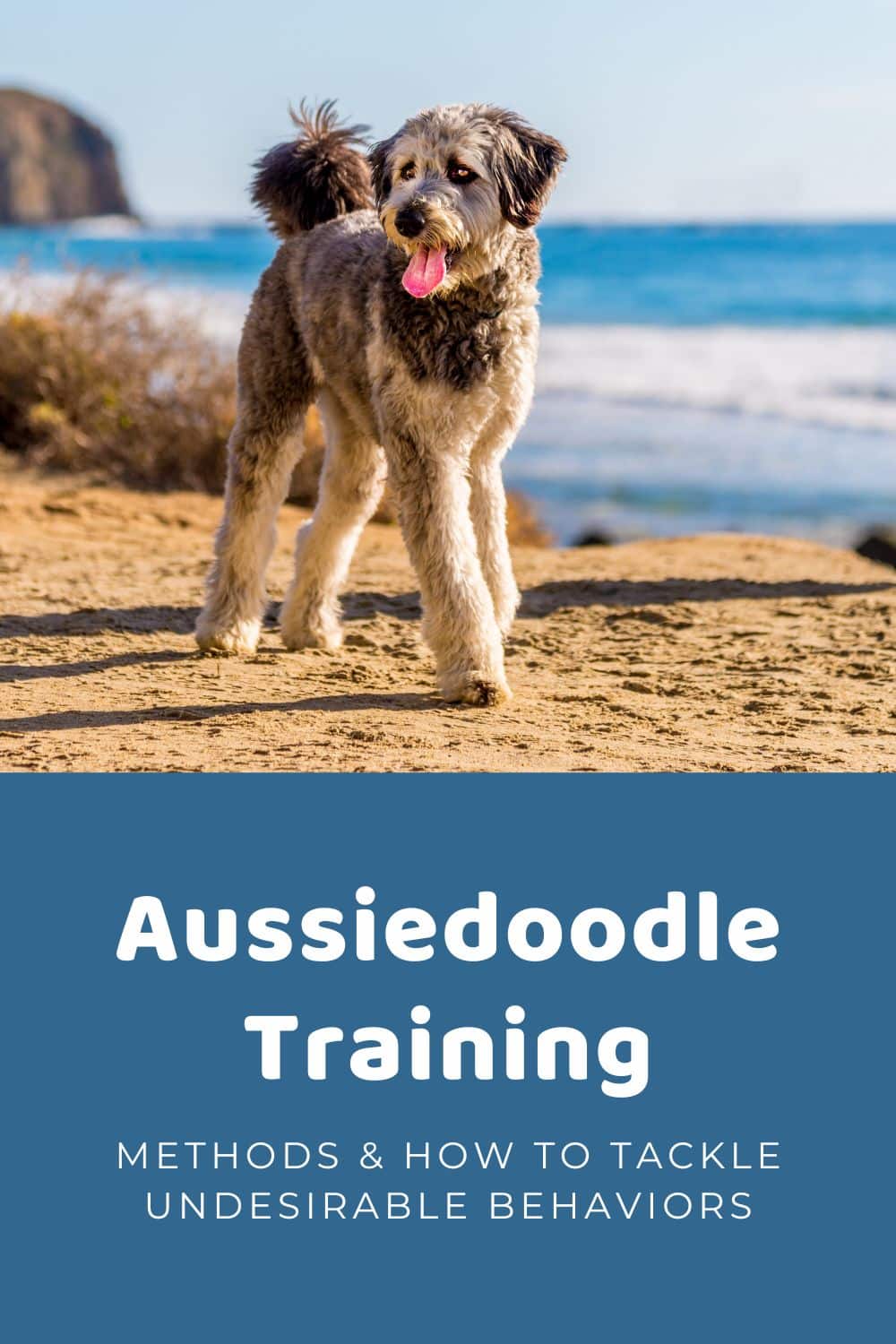Back in the day, before Doodles were a whole thing, choices were somewhat limited. These days Doodles are simply everywhere as more and more people realize just what excellent pets these gorgeous teddy bear dogs make. However, this makes it far tougher for potential newbie owners to decide which to get. Doodles share many things, including the in-demand low-shed coat and their super Poodle intelligence. However, there are plenty of differences too. If you’ve narrowed it down to the Aussiedoodle vs Labradoodle, let us help you go even further. We’ve compiled info on everything from temperament to exercise needs in the hopes of helping you decide on the best Doodle for you.
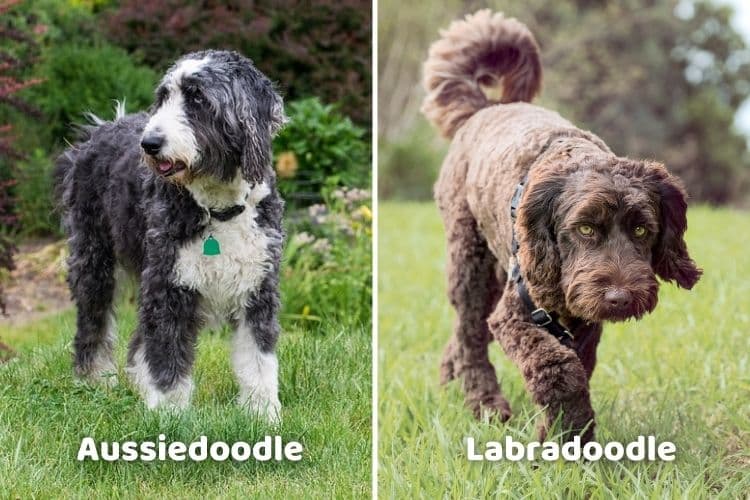
All About Aussiedoodles
A cross between the Australian Shepherd and the Poodle, Aussiedoodles are smart, playful, and beautiful dogs. Less established and well-known than some of the other Doodle breeds but gaining in popularity every day, Aussies have been around since the late 1990s to early 2000s.
Despite their name, the Aussie’s non-Poodle parent – the Australian Shepherd, actually originated in the United States in the 1840s. They were bred to herd livestock and are still very much true working dogs at heart. Poodles were also working dogs, bred to retrieve ducks on the hunt. They retain their impressive working-dog intelligence but are nicely comfortable as companion animals, too.
Aussiedoodles likely came about when people tried to mix in those gorgeous Australian Shepherd coat colors with the new-fangled “hypoallergenic” dogs. As Australian Shepherds hadn’t really been kept as pets until recently, Aussiedoodles can be a little trickier to handle than other Doodles. But they are undoubtedly worth the effort.
All About Labradoodles
Around a little, longer and a lot more well-known, the Labradoodle came about due to the need for service animals that wouldn’t aggravate their owner’s allergies. Ironically, Labradoodles do originally hail from Australia. They were first bred there in the 1980s and have since become in demand across the globe.
Labrador Retrievers, as the name implies, were also bred as retrieving dogs. They were used as fisherman helpers hauling nets and ropes in the freezing North Atlantic seas. However, unlike other retrievers, Labs were likely kept in the home as companion dogs too. That’s why these dogs are considered one of the best family dogs out there and perfect service animals.
Initially, the idea for more hypoallergenic service animals was simply to breed the super-smart Poodle for the job. However, it was discovered that Poodles just don’t have the right kind of temperament for the work. Hence the need to bring in the Labrador Retriever. When mixed with the Poodle, you get a low-shedding animal that’s great with people.
This page is sponsored by our
Featured Labradoodle Breeders
Vancouver, WA
Billings, MT
Newark, OH
Salado, TX
Aussiedoodle vs Labradoodle: Size
Both Aussiedoodles and Labradoodles come in three distinct sizes, determined mainly by the type(s) of Poodle(s) used in the breeding: Toy, Miniature, or Standard. The names, as well as the size standards, vary between the two, though, as can be seen below.
| Aussiedoodles | Labradoodles | |
| Toy | 10-15 pounds 10 inches or less* | N/A |
| Miniature | N/A | Under 30 pounds 13-16 inches |
| Medium | 15-45 pounds 10-15 inches | 30-50 pounds 16-20 inches |
| Standard | 45-70 pounds 15-25 inches | 50-90 pounds 20-26 inches |
As the chart shows, Labradoodles tend to be a little larger than Aussiedoodles. This is because Labradors are a larger breed, outweighing the more medium-sized Australian Shepherd by around 15 pounds. The Standard Poodle sits somewhere in the middle of the two. Obviously, the Miniature and Toy Poodles are much smaller.
Aussiedoodle vs Labradoodle: Temperament
Like pretty much every Doodle out there, Labras and Aussies are known for their friendly, sociable personalities. Both kinds tend to get along with most people, so they don’t make great guard dogs. However, the Labradoodle has the edge on lovability as the Aussie, while keen on their family, can be a little standoffish with people that they don’t know. These dogs tend to develop a solid attachment to just one or two individuals.
The downside of affectionate, larger dogs is the tendency they have to express their happiness at seeing people by launching themselves right at them. This kind of joyful, fluffy missile headed in your direction could knock you flying – this would definitely be the case for smaller children. While it’s tough to discipline such displays of affection, it is necessary to train your dog out of this. Early socialization will also help with keeping your pet calmer in company.
On the whole, though, Labras do tend to be a bit more laidback than the more hyperactive Aussie. They have been kept as companion animals for far longer, and their breeding lines have been influenced by the need for a calmer, more easy-going nature. In practical terms, this makes them happier to be left alone for periods throughout the day. Aussies are more energetic, and slightly brighter pups can quickly get bored when there’s no one around to play with. A bored dog is often a destructive one.
Labradoodle vs. Aussiedoodle: Appearance
In our opinion, every Doodle is absolutely gorgeous with their teddy-bear, happy features, and long, graceful body. When it comes to the Labradoodle and the Aussies, aside from size, the most significant difference between the two is likely to be seen in the coat colors and patterns. There are far more variations in the Aussiedoodle gene pool as Australian Shepherds have more coat shades than Labrador Retrievers.
Labrador Retriever’s come in yummy hues of golden, chocolate, yellow, cream, and even red. However, the Australian Shepherd brings not just cooler tones such as grey and blue but stunning merle coat patterns too. These dogs also tend to be bi- and even tri-colored compared to the Lab and Poodle’s single all-over shade. Don’t even get us started on those blue, grey, and green eye colors they bring to the mix!
Aussiedoodle vs Labradoodle: Grooming & Maintenance
Both Aussiedoodles and Labradoodles stand a chance of inheriting the heavy double-coat from their non-Poodle parents. Otherwise, they could get the curly, single-layered Poodle coat or even a wavy, fleecy coat that sits somewhere in between the two. It’s rarely evident in the puppy what kind of coat they will grow up to have. In that way, it always comes as a nice surprise.
The problem with your pup getting their other parent coat is that both Labrador Retrievers and Australian Shepherds can be big shedders. With the Lab, it tends to be a year-round thing, whereas the Aus tends to shed a little more seasonal – in the spring and fall to adapt to fluctuating temperatures.
So, if the whole reason you’re getting a Doodle is for that “trademark” low-shed coat, then this is definitely something you need to be aware of.
Generally speaking, the more Poodle genes your puppy has, the higher the chance of them getting a low-shed Poodle coat. This is determined by their generation. However, it’s tough to be absolutely sure.
If you do strike it lucky this way, though, you may find you end up with far more work on your hands than you figured. The Poodle coat is one of the most high-maintenance ones out there. Basically, the curlier your pet’s coat is, the more frequently you will need to brush them. This is because dead hair, dust, dander, and more easily get caught up in those stunning curls leading to knots, tangles, and even matting.
The longer you leave it between grooming sessions, the harder it will be to get your brush through their coat. Of course, you could opt for taking your pet to the groomers, but this could work out pricy. Alternatively, check out our handy online course for grooming your Doodle at home.
Labradoodle vs. Aussiedoodle: Health & Wellness
Both Labradoodles and Aussiedoodles benefit from something known as “hybrid vigor.” This basically means that the more varied genes of these dogs, from their two distinct breed parent pups, make them less susceptible to the kind of genetic diseases that can plague pedigree pooches. However, it sadly doesn’t make them immune from every canine condition.
Larger dogs such as the Australian Shepherd, the Labrador Retriever, and the Standard Poodle can suffer from a joint issue known as hip dysplasia. It can be uncomfortable, painful, and even develop into full-blown arthritis. Epilepsy and eye problems like cataracts are also common in these breeds, as are skin and heart problems as they age – especially if they are carrying too much weight.
On the Poodle side, you need to look out for Addison’s disease – an issue with hormone production, Cushing’s disease – a condition caused by a tumor in the pituitary gland, different kinds of cancers, as well as skin and food allergies, sensitivities and intolerances. Both Aussiedoodles and Labradoodles are also prone to ear infections because of their floppy, hairy ears, which can trap water. So you need to take good care of this area of your dog.
The best way to avoid the kinds of diseases mentioned above is to purchase your puppy from a reputable breeder. These health test their breeding animals to ensure they are in tip-top shape and will provide a health guarantee for their puppies, declaring them free from hereditary illnesses – to the best of their knowledge. Giving your pup the best food (here are our top picks for Labradoodles and here for Aussiedoodles) and plenty of exercise can help them remain in good shape.
Aussiedoodles tend to have more energy than Labradoodles, so this is something to keep in mind too. If you’re a more active person or family, always up for plenty of long walks and lots of games and activities, then the Aussie will fit right in. For more cuddle couch time, the Labra might be best. That being said, these pups will still need an hour of exercise or more a day to keep them happy and healthy.
Labradoodle vs. Aussiedoodle: Lifespan
As well as enjoying good health, mixed-breed dogs tend to benefit from a nice long lifespan. Both Aussiedoodles and Labradoodles can be expected to stick around for anywhere between 12 and 15 years.
However, the actual age your pup could live to see depends somewhat on their size as well as their breed. When it comes to canines, littler dogs tend to outlive larger ones by a mile. Experts aren’t exactly sure why, except that it seems to have something to do with the aging of their bodies. So Toy and Miniature dogs will outlive Medium and Standard ones.
Aussiedoodle vs Labradoodle: Training & Environment
When it comes to getting these pups to do what they are told, the Labradoodle is definitely the easier of the two. In fact, these dogs make better beginner dogs overall as, alongside being smart and friendly, they are people pleasers. They are happy to do just what their owner asks of them. Start early and apply a fair and consistent hand, using positive reinforcement methods, and you absolutely can’t really go wrong.
Aussiedoodles, on the other hand, with their inherited herding instincts, tend to try and become the more dominant ones in the household. This is especially the case if they are not given firm and consistent leadership. They may be included to try and boss their family around – especially young children with nipping and chasing behaviors. You shouldn’t punish such tendencies as these are just part of their nature. However, you want to do your level best to train these out of them at a young age. For help with this, you might like to check out Baxter and Bella’s Online Puppy School.
Need help with training?

Use our discount code: DOODLEDOODS at checkout for an instant 25% off of BAXTER & BELLA, The Online Puppy School – an incredible value on their lifetime membership!
Learn More About BAXTER & BELLAIn terms of environment, you’ll want more space for your Aussiedoodle, especially if they are on the larger side. These dogs need plenty of games and outdoor time to keep those massive energy levels in check. Just make sure that your yard is solidly fenced off. These dogs will take any opportunity to escape – digging or jumping their way out of a garden they are not finding that interesting. Keep them happy with fun toys, and you could even look into various different canine sports – these dogs excel at them.
Aussiedoodle vs Labradoodle: Cost
As you probably well know by now, Doodles don’t come cheap. A lot of work goes into their breeding (when you’re dealing with a pro, that is), which is often reflected in the price of these pups. Both dogs can range in price from $1,500 right up to $5,000 depending on the size and generation of the puppies, not to mention the breeding quality of the parents and the services provided by the breeding facility.
Aussiedoodles tend to be more expensive than Labradoodles, though, for three main reasons. Firstly, they are not as prolific, being newer Doodles. Secondly, they have more coat colors, which always translates into more money for the unique factor. Thirdly, they are merle-coated dogs, and breeding these pups is riskier. There are specific health issues associated with genes that create this beautiful effect.
Consider also that you will also have to factor in the cost of keep for any dog you get, which could be as much as $20,000 throughout their lifetime. This includes vet visits, food, grooming, accessories such as crates, toys, beds, treats, and training or boarding. Larger dogs are obviously going to be overall more expensive than smaller ones, but either way, dog ownership can be a costly business.
Aussiedoodle vs Labradoodle: Family Friendliness
All Doodles tend to be great family dogs. However, each works better for different types of families. The Labradoodle and Aussiedoodle are no exception here. As we know by now, Aussies are more energetic, slightly pushier pooches and so do well in a dog-experienced family, with older, more confident children or teens who like to keep active. Labradoodles, with their calmer, gentler nature, are great in quiet, more chilled-out homes and with younger children.
Aussiedoodle vs Labradoodle: Which is the Puppy for You?
At this point, you have probably gauged the clear differences between Aussiedoodles and Labradoodles and have been able to make a choice between them. If not, or if you’re more of a skimmer than a reader, here’s the sum of it.
Opt for an Aussiedoodle if you:
- Live a very active life and are happy to take your dog along for the ride.
- Work from home or have a family set up where there is always someone around.
- Have older children, teenagers, or no children at all.
- Live in a house with a good-sized backyard – plenty of space for your pup to play.
- Have plenty of experience raising dogs.
Choose a Labradoodle if you:
- Are pretty active but also enjoy plenty of couch time with the family.
- Might have to leave your dog home alone from time to time during the day.
- Have younger children who would love to have a pup to play with.
- Live in a place with limited space but close to parks and plenty of good walking routes.
- Have limited or no prior experience raising dogs.
Frequently Asked Questions About Aussiedoodles vs Labradoodles
What is better, a Labradoodle or Aussiedoodle?
The is no straightforward answer to which dog is best between the Labradoodle and the Aussiedoodle. They are both great pups that are suited to slightly different home environments based on their needs and personality. Aussies are active and appreciate plenty of company and fun, and Labras are more chilled out cuddly Doods.
What is the difference between an Australian Labradoodle and an Aussiedoodle?
If you have come across the name Australian Labradoodle, you may be wondering if there is somehow a super three-way combination of all these great dogs. In actual fact, the Australian Labradoodle is a three-way cross but between a Labrador Retriever, a Poodle, and a Cocker Spaniel. The Cocker was added as it brings more consistent traits to the mix than the other two. On the other hand, the Aussiedoodle is a cross between an Australian Shepherd and a Poodle.
Are Aussiedoodles good dogs?
Aussiedoodles are excellent dogs for owners who have the time, energy, and capability to deal with them. These super dogs add a whole other layer of smarts to the already ultra-intelligent Poodle. With this, you can train them to be good at just about anything. Beyond that, their vast array of coat colors and patterns means that you will end up with a truly unique dog if you do opt for one of these.
Picking the perfect dog for your family setup is no easy decision. It’s something that you’ve likely been pondering on for a while before landing on these two options. Hopefully, the information included here comparing the rambunctious Aussiedoodle with the gentle Labradoodle has helped make things a little clearer for you. We are absolutely sure that whichever one you end up opting for will be one of the best decisions of your life.












